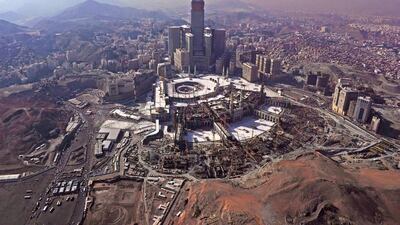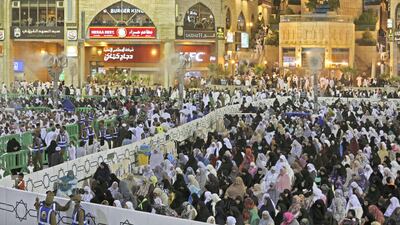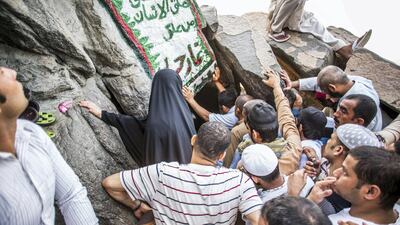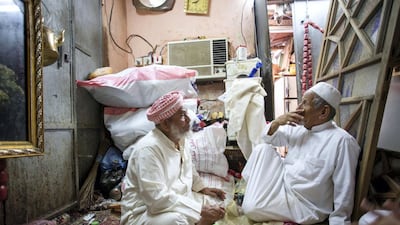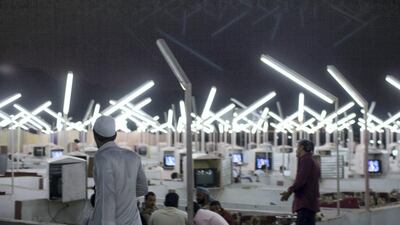In Learning from Gulf Cities, the exhibition of urban photography that recently opened at New York University Abu Dhabi, the show's curators insist that rather than being exceptional, the cities of the Arabian Gulf are merely particularly extreme examples of widespread global trends. If that is the case, then similar rules would also seem to apply when it comes to Makkah, the city on the other side of the Arabian Peninsula that occupies an exceptional place in the hearts and minds of 1.8 billion Muslims worldwide.
With an estimated population of 1.5 million, Makkah is the product of forces that combine the local and the global, modernity and tradition, and the sacred and the profane, in ways that are ostensibly unique. More than 1.8 million Muslims performed Hajj in 2016 and, according to the Kingdom of Saudi Arabia’s Vision 2030 plan, more than 15 million Muslims are expected to perform Umrah annually by the year 2020 and more than 30 million by the year 2030.
Last year, more than 8 million visitors performed Umrah during the holy month of Ramadan alone.
The result is not only landmark projects such as the Abraj Al Bait, a cluster of seven skyscrapers that culminate in the 601-metre-tall Makkah Royal Clock Tower, but the development of informal settlements that are estimated to house approximately 40 per cent of Makkah's total population, large numbers of whom are pilgrims who have remained in the city and now constitute a significant proportion of migrant labour.
Both sides of this remarkable urban transformation have been recorded by the Saudi artist and photographer Ahmed Mater since 2008, in a series of works that are about to go on display in an exhibition at the Brooklyn Museum.
"What started as a desire to show only the changes taking place has ended with a full and exhaustive depiction of a site that can be accessed only by those of the Islamic faith," the artist explains in statement that accompanies Ahmed Mater: Makkah Journeys.
“This collection of images, with their diverse and extreme points of reference, represents the deliberately experimental, meandering, and serendipitous nature of my journey to the heart of Makkah. They are testaments to the cultural and political conditions of contemporary Saudi society.”
Featuring large-scale photographs from his 2016 project Desert of Pharan: Unofficial Histories Behind the Mass Expansion of Makkah, the exhibition also includes more intimate portraits of the city's diverse inhabitants, workers and migrants, who are drawn from more than 80 nationalities, while chronicling the influx of wealth that is transforming the city.
As is so often the case in the history of urban photography, it is often the seemingly extraordinary visions of a culture that end up being the most enduring and formative, and it seems that Mater’s photographs will come to define how the public see and understand Makkah at this pivotal moment in its history.
As Makkah is inevitably transformed in the coming decades, Mater’s haunting shots of the city’s traditional backstreets will surely perform a similar role to the images of old, pre-Haussmann Paris that were created by the photographer Charles Marville in the 1860s, which simultaneously captured the disappearance of one way of life and the emergence of others.
“I need to be here, in the city of Makkah, now, experiencing, absorbing, and recording my place in this moment of transformation, after which things may never be the same again,” states Mater, a trained physician who abandoned his career in medicine to become a full-time artist.
“It has become important for me to identify with this place and to understand how this constellation of change, as well as the forces that are shaping it, will affect the community of which I am a part.”
In documenting its specific patterns of wealth and luxury, migration and labour, the artist shows that even in this most unique of cities it is the familiarity and commonality of the urban experience that is the true revelation. Extreme, yes. Exceptional, certainly, but Mater’s vision of Makkah is also undeniably humane.
Ahmed Mater: Makkah Journeys runs at the Brooklyn Museum from December 1 to April 8. For more details, visit www.brooklynmuseum.org
__________________________
Read more:
NYUAD exhibition shows the global influence of the Gulf's cities
Art Jameel launches major commissions programme for new, Dubai-based works
Not alone, but first: Saudi women curate British contemporary art
__________________________
The Breadwinner
Director: Nora Twomey
Starring: Saara Chaudry, Soma Chhaya, Laara Sadiq
Three stars
Company profile
Name: Thndr
Started: October 2020
Founders: Ahmad Hammouda and Seif Amr
Based: Cairo, Egypt
Sector: FinTech
Initial investment: pre-seed of $800,000
Funding stage: series A; $20 million
Investors: Tiger Global, Beco Capital, Prosus Ventures, Y Combinator, Global Ventures, Abdul Latif Jameel, Endure Capital, 4DX Ventures, Plus VC, Rabacap and MSA Capital
The burning issue
The internal combustion engine is facing a watershed moment – major manufacturer Volvo is to stop producing petroleum-powered vehicles by 2021 and countries in Europe, including the UK, have vowed to ban their sale before 2040. The National takes a look at the story of one of the most successful technologies of the last 100 years and how it has impacted life in the UAE.
Read part four: an affection for classic cars lives on
Read part three: the age of the electric vehicle begins
Read part one: how cars came to the UAE
KILLING OF QASSEM SULEIMANI
Fund-raising tips for start-ups
Develop an innovative business concept
Have the ability to differentiate yourself from competitors
Put in place a business continuity plan after Covid-19
Prepare for the worst-case scenario (further lockdowns, long wait for a vaccine, etc.)
Have enough cash to stay afloat for the next 12 to 18 months
Be creative and innovative to reduce expenses
Be prepared to use Covid-19 as an opportunity for your business
* Tips from Jassim Al Marzooqi and Walid Hanna
THE SIXTH SENSE
Starring: Bruce Willis, Toni Collette, Hayley Joel Osment
Director: M. Night Shyamalan
Rating: 5/5
Ten tax points to be aware of in 2026
1. Domestic VAT refund amendments: request your refund within five years
If a business does not apply for the refund on time, they lose their credit.
2. E-invoicing in the UAE
Businesses should continue preparing for the implementation of e-invoicing in the UAE, with 2026 a preparation and transition period ahead of phased mandatory adoption.
3. More tax audits
Tax authorities are increasingly using data already available across multiple filings to identify audit risks.
4. More beneficial VAT and excise tax penalty regime
Tax disputes are expected to become more frequent and more structured, with clearer administrative objection and appeal processes. The UAE has adopted a new penalty regime for VAT and excise disputes, which now mirrors the penalty regime for corporate tax.
5. Greater emphasis on statutory audit
There is a greater need for the accuracy of financial statements. The International Financial Reporting Standards standards need to be strictly adhered to and, as a result, the quality of the audits will need to increase.
6. Further transfer pricing enforcement
Transfer pricing enforcement, which refers to the practice of establishing prices for internal transactions between related entities, is expected to broaden in scope. The UAE will shortly open the possibility to negotiate advance pricing agreements, or essentially rulings for transfer pricing purposes.
7. Limited time periods for audits
Recent amendments also introduce a default five-year limitation period for tax audits and assessments, subject to specific statutory exceptions. While the standard audit and assessment period is five years, this may be extended to up to 15 years in cases involving fraud or tax evasion.
8. Pillar 2 implementation
Many multinational groups will begin to feel the practical effect of the Domestic Minimum Top-Up Tax (DMTT), the UAE's implementation of the OECD’s global minimum tax under Pillar 2. While the rules apply for financial years starting on or after January 1, 2025, it is 2026 that marks the transition to an operational phase.
9. Reduced compliance obligations for imported goods and services
Businesses that apply the reverse-charge mechanism for VAT purposes in the UAE may benefit from reduced compliance obligations.
10. Substance and CbC reporting focus
Tax authorities are expected to continue strengthening the enforcement of economic substance and Country-by-Country (CbC) reporting frameworks. In the UAE, these regimes are increasingly being used as risk-assessment tools, providing tax authorities with a comprehensive view of multinational groups’ global footprints and enabling them to assess whether profits are aligned with real economic activity.
Contributed by Thomas Vanhee and Hend Rashwan, Aurifer
Desert Warrior
Starring: Anthony Mackie, Aiysha Hart, Ben Kingsley
Director: Rupert Wyatt
Rating: 3/5
